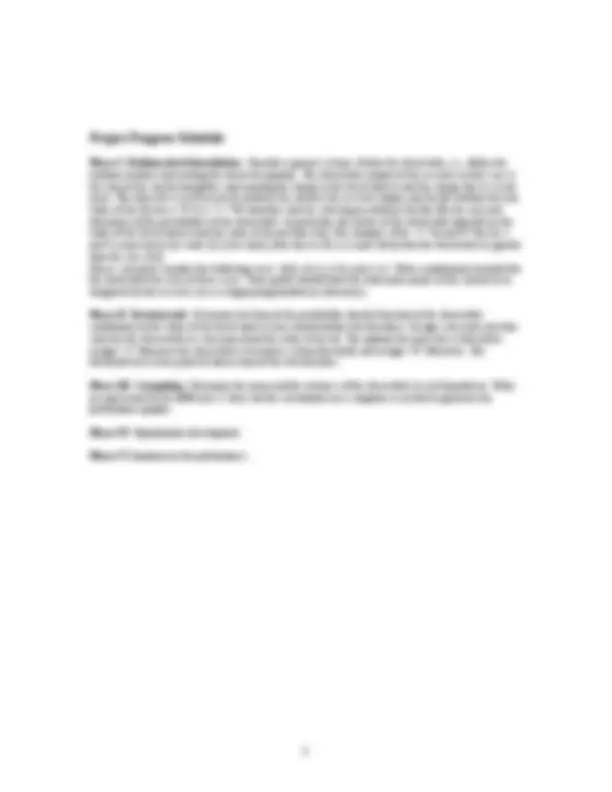



Study with the several resources on Docsity

Earn points by helping other students or get them with a premium plan


Prepare for your exams
Study with the several resources on Docsity

Earn points to download
Earn points by helping other students or get them with a premium plan
Community
Ask the community for help and clear up your study doubts
Discover the best universities in your country according to Docsity users
Free resources
Download our free guides on studying techniques, anxiety management strategies, and thesis advice from Docsity tutors
A term project for ece-542 (spring 2004) where students are required to collaborate in small groups and analyze the performance of an on-off keying (binary) direct-detection optical communication system. The project involves calculating the bit-error rate (ber) and receiver sensitivity (s) as functions of fiber-coupled power, transmission data rate, circuit noise parameter, and number of fiber sections. Students are expected to use the available components, including an ingaasp led, fiber sections, and an avalanche photodiode, to perform the analysis. The document also provides references for further study.
Typology: Study Guides, Projects, Research
1 / 3

This page cannot be seen from the preview
Don't miss anything!


DUE DATE: Thursday, May 6, 4PM LATE SUBMISSIONS ARE NOT ACCEPTED
General remarks: You are asked to collaborate with each other in small groups. Each student must submit his/her own report. The report must include an introduction, analysis, numerical results, thorough discussion of the results, a conclusion, and references. Lengthy derivations should be included in an appendix. I expect to see typed reports that are at a professional level of quality. All figures, graphs, and tables must be adequately labeled and captioned. The report must be connected and exhibit smooth logical flow. Start early!
Project description: This project involves the performance analysis of an on-off keying (binary) direct-detection optical communication system. In such a system, a binary stream of data is used to modulate a light source. The modulated light is transmitted through a series of fiber sections that may involve the detection and regeneration of light prior to each new section. At the destination, a synchronous receiver observes the signal for the duration of each bit and decides whether a high (on-light) or low (off-light) signal was sent by the transmitter in the prescribed bit. The performance of the system can be measured by the bit-error rate (BER), defined as the average probability of a bit error. The BER is typically plotted as a function of the transmission rate R (bits per second), the optical energy per bit, length of the fiber, etc. Another common measure of performance is the receiver sensitivity S , defined as the minimum mean number of photons per bit necessary to achieve a BER of 10 -9.
The performance of an optical communication system is governed by the performance of its components, which consist of the transmitter, the link, and the receiver. Factors that affect the performance of the transmitter include the responsivity of the light source, its bandwidth (time response), and the transmitter-to-fiber light coupling efficiency. The performance of the link is governed by the length of each section, the number of repeaters, attenuation loss, modal, material, and polarization-mode dispersion, inter-link connector loss, etc. For lack of relevance to this course, repeater loss and all forms of dispersion will be ignored in this project. The performance of the optical receiver is governed by the detector gain noise (uncertainty), shot noise, circuit noise, bandwidth of the receiver (which gives rise to intersymbol interference, ISI), and possibly background radiation noise. We will assume that the receiver integrates the photocurrent over the duration of a bit (i.e., it measures the accumulated charge per bit) and compares it to an optimal threshold. This receiver is called an integrate-and-dump receiver. A common simplifying assumption in the BER calculations is that the receiver output signal (prior to the decision stage) is assumed to be Gaussian.
We begin by listing the available components:
a) InGaAsP LED with a 0.1mW maximum fiber-coupled power, and a bandwidth of 3 GHz. b) Fiber sections, each 500 m long, with 1.5 dB/km attenuation at a wavelength of 1300 nm. c) An avalanche photodiode (APD) with a mean gain in the range 5-50 and quantum efficiency of 0.4 at 1300 nm (see Ref. 1, Ch. 17 and become familiar with APDs and their gain statistics). Assume that the random impulse response (response when a photon is absorbed) of the APD is
electronic charge, and u ( t ) is the unit-step function. Also assume that the additive zero-mean Gaussian noise has two-sided power spectral density of 1.0x10 -23^ (W/Hz).
Comment on the performance of the above system by performing the following tasks:
Remarks:
Your performance analysis should include the effects of: a) Shot noise: resulting from the random nature of the arrival times of photons. b) Circuit noise in the receiver circuitry. c) Time-response limitations of the APD. d) Attenuation losses in the fiber sections. e) Intersymbol interference from neighboring bits. f) You may ignore the RC effects of the receivers (i.e., assume that the RC time constant is negligible compared to the photocurrent integration time).
References